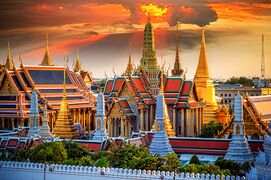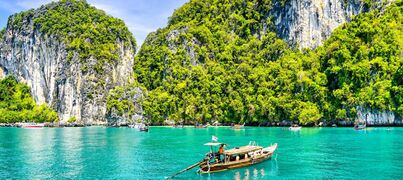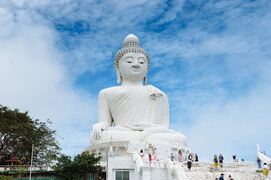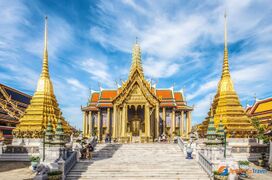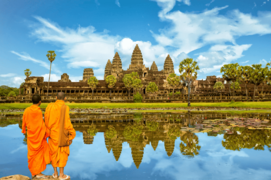Thervala: Difference between revisions
mNo edit summary |
mNo edit summary |
||
| Line 182: | Line 182: | ||
Kittiphop, as it turns out, had grown to be a wise and fair king of Langsari. Although his anger never fully went away, he had learned to cope with it through meditation. Foreseeing potential action against him from either one or both of his brothers, Kittiphop spent a considerable amount of his trade income on the building of fortifications all over the steppes. These include a vast number of fortresses and a networl of tunnels. | Kittiphop, as it turns out, had grown to be a wise and fair king of Langsari. Although his anger never fully went away, he had learned to cope with it through meditation. Foreseeing potential action against him from either one or both of his brothers, Kittiphop spent a considerable amount of his trade income on the building of fortifications all over the steppes. These include a vast number of fortresses and a networl of tunnels. | ||
When Jirayuwat's armies came into the steppes, they had an incredibly hard time making any territorial gains whatsoever. The war that Jirayuwat had declared on his brother had become a financial quagmire for the kingdom in as little as a few months into the campaign. | When Jirayuwat's armies came into the steppes, they had an incredibly hard time making any territorial gains whatsoever. The war that Jirayuwat had declared on his brother had become a financial quagmire for the kingdom in as little as a few months into the campaign. Kittiphop sent a messenger to their brother, Songkiat, requesting help defending against Jirayuwat's invasion. In response, Songkiat set up a naval blockade along the coasts of Siwilai. | ||
===Vassalization under the Myanga Ayil Khanate=== | ===Vassalization under the Myanga Ayil Khanate=== | ||
Revision as of 18:02, 29 October 2024
Thervala ("The Kingdom of Thervala") Ratcha-anachak Ther (Ther) | |
|---|---|
|
Flag | |
Motto: ชัยชนะด้วยเลือด ("Victory through blood") | |
Anthem: | |
 Location of Thervala (dark green) In Audonia (gray) | |
| Capital and largest city | Wat Kram |
| Official languages | Ther |
| Demonym(s) | Ther (noun) Ther (adjective) |
| Government | Constitutional Monarchy |
• King | Ananda Varma II |
• Prime Minister | Chatchai Suriyawan |
| Legislature | National Assembly |
| Senate | |
| House of Representatives | |
| Establishment | |
| Population | |
• Estimate | 80,000,000 |
| GDP (PPP) | estimate |
• Total | 23,000 |
| GDP (nominal) | estimate |
• Total | 560,000,000 |
• Per capita | 7,000 |
| Gini | Your gini coefficient Error: Invalid Gini value |
| Currency | Rathan (RTH) |
| Driving side | right |
'Thervala' (Terwalaah), officially the 'Kingdom of Thervala', is a constitutional monarchy in Audonia. It is neighbored by Oyashima and Metzetta
Although the modern state that is the Kingdom of Thervala has only existed for a few centuries, people have been living in that region of Audonia since prehistoric times. Archaeological findings that date back to prehistory are sparse, but what has been found suggests that the prehistoric Ther people were a religious society, potentially theocratic in nature. It is also known that this prehistoric society subsisted largely off of trade and fishing.
The borders of the Kingdom of Thervala have remained consistent since the forming of the original Vishran Dynasty. The historical kingdoms of Thervala have either been ruled by foreign dynasties or vassalized under stronger foreign powers. It was not until the 20th century that Thervala became a completely autonomous nation. This process was done in mutual cooperation between Burgundie and Thervala. Some academics argue that the modern state of Thervala is still under the thumb of Burgoignac rule, but a majority of academics see this as another form of the famous Global Burgieman conspiracy theory.
The earliest recorded state in the region was a Peshabi dynasty of nobles from the Arunid Empire known as the Vishran Dynasty. They came to the Ther region of Audonia in 200 BCE. The Vishran Dynasty introduced written language and civilization to the indigenous Ther population. Much of ancient Ther culture was adapted from the Peshabi culture of the Vishran Dynasty. This process is academically known as Arunidisation. The Vishran dynasty came to its eventual end due to the conquests of the Myanga Ayil Khanate. The capitulation of the Vishran Kingdom was largely bloodless, except for the Peshabi ruling class, who had become infamous for their hedonism and brutal style of ruling.
Because the Ther were collaborative with the Great Khan, the Khram dynasty was installed as a vassal under the Khanate in 1300 CE. This dynasty was responsible for the founding of the Kingdom's capital city, Wat Khram. The Khram dynasty also issued edicts in regards to the development of the kingdom's civil and legislative codes and made the state religion Theravada Buddhism. Thervala traces its martial culture to the Khram dynasty, as part of the vassalization required the dynasty to provide the Khanate with a steady supply of well trained and well supplied troops to assist in the Khanate's conquest of Audonia. Ther academics argue that Thervala was integral to the Khanate reaching its zenith in the 14th and 15th centuries. This is largely attributed to the extended use of Elephant cavalry and manpower that Thervala expended as tithe to the Khanate.
The Khram dynasaty were loyal to the Khanate for centuries, largely due to the protection that was provided as well as the Khanate's laissez faire policy towards Ther self-determination and national identity. As conquests started to take a toll on the Ther population, a sentiment for independence began to develop. It wasn't until 1650 that the Khram dynasty came into contact with the Duchy of Martilles and the Martillien North Levantine Trading Company (MNLC). Upon establishment of diplomatic missions, the Khram dynasty was more than willing to act as a collaborative force against the now hated Khanate.
As a protectorate of the Duchy of Martilles, Thervala went through the process of Occidentalization, with the MNLC supplying and funding the Khram dynasty with state of the art arms and armor, as well as modernizing the Kingdom's administration. Despite the Khram dynasty's cooperation with the Dutchy of Martilles, the stipulations in the establishment of the protectorate stated that a new and more subservient dynasty must be installed, due to the highly nationalist sentiment that had developed within the Khram administration. After a holistic investigation of the Khram dynasty's clans, the MNLC selected a cadet line known as the Sukhavijaya. The new king, Suriyavarman, worked closely both with MNLC and the neighboring Yuganagawa Protectorate, administered by the Duchy of Marialianus' Ularien Trading Company, in battles against the Myanga Ayil Khanate. This close relationship with Maritime Dericania and their Oyashimane protectorate has influenced modern Ther culture immensely, with many loan words coming from Burgoignesc and Oyash.
The Sukhavijaya dynasty is widely seen as the founding dynasty of modern Thervala. Suriyavarman worked very closely with the MNLC to completely modernize the country from the ground up. He expended a good amount of the royal treasury into hiring Burgoigniac scholars to come into the country and translate texts from the Occidental world into Ther. As such, a wealth of treatises on politics, philosophy, medicine, and science became available to Ther nobility.
After Ther decolonization, the Sukhavijaya dynasty ended with the abdication of King Anantadeva. After the abdication, the Ther nobility selected a noble from the Varma-Khram dynasty, which was another cadet line from the then defunct Khram dynasty. The newly selected king, Ananda Varma kept close relations with Burgundie and has helped maintain Burgoigniac interests in Audonia, most notably in the war effort during Operation Kipling. During this time, Burgundie armed, trained, and funded the Kingdom's army. Due to the militarization of the country, a royalist, anti-communist military dictatorship was installed. Although the king was recognized as the head of state, the military junta had total control over the government. This military dictatorship lasted until 1980, when a coup installed a democratic, civilian government.
After Operation Kipling, Thervala saw economic prosperity and growth throughout the 1980s. Wat Khram became a burgeoning financial hot spot and Thervala became renown as a tax haven. The 1980s saw a great deal of real estate enter the domestic ther market as well as new companies spring up in Thervala. More infamously, the Ther government invested a large amount into mega projects whose ruins can still be seen in the country today. This is due to the popping of the bubble economy in 1991 which lead to an economic implosion and subsequent migration crisis. Thervala faced widespread civil unrest, crime, and rioting due to the government's decision to bail out the banks instead of paying its people what they were promised in the form of pension and social security.
Due to the civilian government's tactful thinking, the economic crisis was dealt with within the decade. The government was able to reduce deficit spending as well as cut down its spending on the military. This allowed the government to maintain its commitment to the people while still being able to function. The late 1990s and saw the Kingdom's slow rise in stability as tourists from around the world flocked to Thervala due to low taxes, weak currency, and red light tourism. While at the time seen as a great thing for the Ther economy and a path towards economic prosperity, contemporary scholars and economists say that such tourism is no longer as fruitful to Thervala.
The King of Thervala no longer has any power on paper, but is very much still the de facto ruler of the nation. In many ways the current civilian government is largely symbolic, due to the Royalist party's stranglehold on the upper and lower houses. Political movements that aim to dislodge the Royalist gridlock usually lead to mass arrests under Lèse-majesté and sometimes assassinations. Thervala's far reaching Lèse-majesté laws are a result of its decades long military dictatorship and its close involvement in Operation Kipling.
Thervala is a member of the League of Nations.
Etymology
The Ther people are the indigenous ethnic group of Thervala, and in the Ther language “Ther” directly translate to “Person” or “People”. “Vala” in Ther is an honorific title meant to denote a holiness or purity. Thervala is then representative not only of the borders of the country itself, but also its people. The Land of the (Holy People).
History
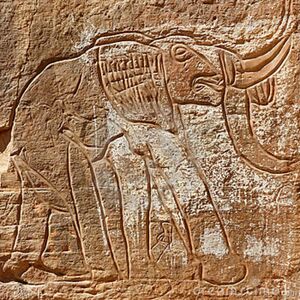
Prehistoric Age
In prehistory, Thervala was comprised of small, religious tribes that lived in fishing communities in and around the East Audonian wetlands. A majority of what is known from this time period comes from bog bodies found in and around swamps near major pre-historic settlements. It is heavily theorized that these bog bodies are instances of ritual sacrifice. Bodies of prehistoric man are not the only things preserved by Thervala's many swamps. Due to the large amount of marshlands in the country, there have been many prehistoric fauna that have been preserved in Ther bogs. Such discoveries have made Thervala a hot spot for zoological and anthropological archaeologists alike.
Aside from bog preservation, Ther archaeology is typically centered around a handful of sites where there were once prehistoric communities. The largest and most famous of which has been dubbed "Chang City" due to the amount of Ivory found in and around the site as well as many unearthed murals depicting Elephants. A large amount of cultural artifacts, mosaics, and jewelry have also been found within the site at Chang City, leading to speculations that it was a prehistoric trade hub.
Arunidisation
Arrival in Northern Dolong Wetlands and the Reign of Habass
In the 4th century BCE Buddhist princes that were expelled by the Zoroastrian Emperor of the Arunid Empire Aadesh. These landless princess followed historical Arunid trade routes until they came upon the Ther people in the far north of Audonia. Upon discovering the indigenous and underdeveloped Ther people, the Arunid princes thought it was their religious duty to enlighten the Ther. They introduced written language to the Ther people and divided the land into realms that would be distributed among the princes. Historically, these entites existed more as monarchal city states that coexisted peacefully with one another. Arunidisation saw the introduction of Wet Rice Agriculture, The Sanskrit writing system, and advancements in administrative and legal thought. By and large, the Arunids brought modern civilization to the Dolong wetlands.
As the Vishrani princes started to die, the initial realms that were created and distributed equally started to be inherited by the eldest prince of the Vishran dynasty, Habass. Habass eventually outlived all of his brothers and inherited all of the realms. This happened solely because he had chosen to enter into a monogomous relationship wheras the other Vishran princes were notoriously polygamists. Habass was the only one who could definitively inherit titles because the other princes never selected wives that could rule as regents or give heirs.
Habass named the new and united kingdom "Arunthala". Habass ruled benevolently over Thervala and allegedly lived to be 120 years old. The historicity of this claim is dubious at best as most records from the time were lost during the Myanga Revolts. Much of the history of Habass and his reign is heavily mythologized in Ther folklore and culture. In Ther folk tradition, Habass was a hero who slew the native Ther fish god and released the Ther people from its rule.
After the death of Habass, the crown was inehrited by his son, Chandravarman I.
Chandravarman I
Contemporary scholars believe that Chandravarman ruled over Arunthala from between 330 and 300 BC to around 250 BC.
The reign of Chandravarman saw an expansion of administrative and legal code within Arunthala. His first major action as king was to create an extensive tax code to fund projects all across the kingdom. This tax code was considered to be incredibly ahead of its time, with varying laws for taxation of individuals based on factors such as number of family members in a household, occupation, and social status. As a devout Buddhist, these things were important to Chandravarman when it came to tax. For an average family, the annual tax was two sacks of rice. Farmers were taxed a wagon's worth of rice.
Chandravarman also created one of the world's first instances of social security. Half of all rice tax in Arunthala was held onto by the kingdom to be distributed to poor people, Buddhist monks, and the sick. This was known as the Rice Hoard. Arunthala also saw the development and expansion of the city of Wat Vishran as well as the start of projects such as the Heavenly Temple of Divine Providence, the roads and tollways of Arunthala, and most notably, The Golden Barge.
Chandravarman was responsible for the establishment of diplomatic ties with the Dahmong nomads in what is now known as Oyashima. Chandravarman personally oversaw the hiring of some one thousand Dahmong nomads to act as a standing military to protect the Arunthal kingdom. This early military was able to train the Ther people in horse archery as well as swordsmanship. Nationalist Ther scholars hypothesize that it was not the Myanga that trained the Ther in Elephant cavalry, but the nomad mercenaries, due to their competence and experience with mounted combat.
Chandravarman left Arunthala to his only son, Chandraputra.
Chandraputra
Chandraputra is much more well documented figure, thanks to the growing education of Arunthala. He ruled from 250 BC to 230 BC. Despite his religious upbringing, Chandravarman was known to be greatly affectionate towards Chandraputra. He showered his son in gifts of exotic animals, women, wine, and food. Chandraputra's father died when he was approximately sixteen or seventeen years old. Having no experience in nation building to the degree of his forefathers, Chandraputra oversaw a hedonistic, brutal rule. Records regarding punitive action show that Chandraputra was more than willing to maim or even kill minor offenders. Contemporary scholars suggest that this could even be influenced by how he was feeling at any given time.
He doubled taxation on the native Ther people and would allegedly take a finger per year taxes weren't met. If a subject was behind on taxes for five years accumulatively, they would lose a hand. Chandraputra also oversaw the introduction of a debtor's prison so that debts in private matters could forcibly be handled. Chandraputra also oversaw the great selling of the Rice Hoard, which amassed the kingdom a large fortune once it was depleted. Many bog bodies date back to this time, it is hypothesized that poor, rural Thers made human and animal sacrifices for better crop yields. This is due to the high levels of taxation and no alleviation from the king.
Such mismanagement of the country lead to dissatisfaction of even the most loyal Arunid nobility. While most benefited from his decisions to increase the personal wealth of the court, they knew that the Ther people had now been martially educated. The king's Council of Advisors personally met with him and tried fruitlessly to challenge his style of ruling through reminding him of his father, meetings with court monks, and taking him to the rural provinces of Arunthala. Still, Chandraputra would not yield.
The council of advisors could not foresee a long lasting future of the kingdom with Chandraputra's reign. He had no heir and allegedly amassed a harem of 99 mistresses. In winter of 230 BC, the council invited Chandraputra to a cruise on the river Thak'Tee (then known as Sarayu) and stabbed him to death. They then fed him to the river crocodiles. After deposing the king, the council met and decided to elect a monarch from the ward of the court monk, Sumedha. This decision was made due to the council wanting to mitigate the chances of having another corrupt monarch and saw it fit that someone raised with discipline in the Buddhist faith would never be so corrupt.
Sumedha selected a young boy who he claimed had "The mark of heaven" upon him named Jinaputra. Sumedha claimed that it Jinaputra's destiny to be the king of Arunthala. Jinaputra was still much too young at this time to become the king of Arunthala, so the council of advisors drafted a law that would make them a council of regents if ever a monarch was unfit to rule.
First Council of Regents
The first council of regents in Ther history were tasked with a difficult challenge in repairing the great mess that Chandraputra made. Many of Chandraputra's mistresses had gotten pregnant and given birth to what they perceived to be as pretenders to the throne of Arunthala. Most notably, the eldest illegitimate child of Chandraputra and a Ther woman known as Lalana, Thammarat. Thammarat was able to muster a small army of followers that laid siege to Wat Vishran. He claimed to be the true heir to the throne of Arunthala and that due to his mixed Arunid-Ther ancestry, he would be the key to unifying the two groups. Most of his followers saw him as a messiah figure who would deliver the common Ther people to the elevated social status of the Arunids.
In 245 BC, Thammarat laid siege to the Royal Palace in Wat Vishran. Although normally such a situation would be dealt with swiftly, the council of regents feared retribution from the Ther people for squashing such a rebellion. So the siege lasted an entire fourteen days as the council met and decided on what to do. It was finally decided that Thammarat could not be reasoned with. The council then ordered the Royal Army to storm out of the castle and face Thammarat's forces.
The underequipped and undertrained army that Thammarat had mustered crumbled quickly from the career soldiers of the Royal Army. The fighting only lasted an hour and a half. Thammarat was apprehended and put to trial under the council of regents. There, he was convicted of murder for not only the deaths and injuries sustained by the Royal Army, but also the deaths of his own men. He was sentenced to be burned alive until grievously injured, kept alive until he was stable again, and banished from Arunthala.
After Thammarat's Rebellion, the council of regents sought to restore the rice hoard to its former size. In doing so, long term stability and safety from famine would be ensured. The only option that the council could foresee this coming to fruition, however, was to quadruple the taxes temporarily. They did not enact the same levels of punishment as Chandraputra on people who could not afford to pay their taxes. Those who could not afford to do so were simply instructed to pay the highest amount that they possibly could and that the rest of the debt would be forgiven. This was a largely honor based system, and lead to the council discussing a potential auditing system to ensure that their magnanimity was not being taken advantage of.
Janiputra the Great
Janiputra ascended to the throne in the year 240 BC. The kingdom was on the verge of a total rebellion due to the tax legislation and the perceived subpar performance of the council of regents. During Janiputra's time as a ward of the council, he was tutored personally by the kingdom's top minds on topics such as Theology, Mathematics, History, and Military strategy. He knew that as king he would either have to make concessions to the Ther people or oppress them. He chose the latter, and began sweeping reforms of the military. Every third Ther man between the ages of fifteen and forty was drafted into the royal army. These drafted soldiers would be entitled to land rights and a small amount of wealth if they survived to the end of their tenure.
Janiputra then overhauled the legal code of Arunthala. Despite his predecessor's cruelty, Janiputra saw use in discipline of the public. Growing up in the religious manner that he did, Janiputra saw discipline and harmony as key to not only a healthy life, but a healthy society. Much of his legal reform was his attempts to make Arunthala a perfect Buddhist society. Likewise, Janiputra's legal code viewed inflicted punishment as karmic. His default sentencing by and large was to have the action done upon the offender. He banned the consumption of all animals and animal products, extending this to seafood as well. Even the harming of animals was punishable if one was caught. Janiputra's legal system was so successful that it was maintained as the de facto code of law in Arunthala well into the time of the Myanga.
Due to his shrewd diplomacy and large retinue of court merchants, Janiputra amassed a large amount of wealth within Arunthala. A majority of this wealth was used to fund infrastructure projects all over the kingdom. Most notably, a system of roads that connected Wat Vishran to major towns around the area as well as roads to connect regions to one another. There was also a great land reclamation movement under Janiputra so that the monarchy would have long term insurance that they'd be able to fulfill its promises of land to draftees. Some of this wealth was also distributed to Ther people who were willing to migrate from their villages to the far reaches of the kingdom, such as the northern islands and Langsari. Formal diplomatic relations with the ancient Kingdom of Metzetta were started during this time. Surviving records show that this was one of Arunthala's more lucrative trading partners, due to Arunthala's access to Arunid and Huoxian trade goods.
War of the Steppes
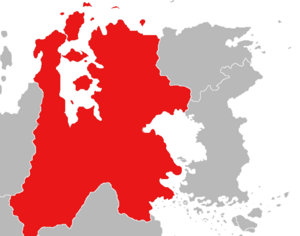
Arunthala's population started to boom due to the high quality of life, food security, and standard of living provided by the kingdom. Janiputra had also grown the army to an approximate size of fifty-thousand men. His vision for a great Buddhist society gave him the ambition to expand Arunthala. He did not believe in betraying the established diplomatic trust with the nomadic Dahmod kingdoms of the east and believed that crossing an army over the Sarayu would be logistically impossible. He came to the conclusion that the only reliable route of expansion for the kingdom was to the south.
While no formal diplomatic contact was made as of yet, trade with the region revealed that the people living there were step nomads, much like the Dahmod. As the Dahmod did not live under a unified kingdom, Janiputra correctly assumed that the southern nomads also had no such form of cohesion. As such, he personally oversaw a campaign into the foothils of dolong.
Although Janiputra was correct in his assumptions about the southern nomads, who were referred to by both the Ther and the Arunid nobility as "Khon Dong" (Wild People), he did not foresee that the military action would take as long as it did. The Arunthala army was vast and very well disciplined, one of the strongest armies on the continent at the time. However, it was inexperienced in actual combat and had no idea how to properly react to the hit and run tactics of the Khon Dong. Although his generals speculated that a more offensive strategy would prove to be successful, Janiputra had no desire to raze the smaller villages of the Khon Dong. He saw such a thing as immoral. Instead, Janiputra devised tactics to deal with the more unconventional style of warfare. His troops who were normally used to using long, curved swords, were fitted with spears instead. He then ordered them into square formations, protecting the flanks from cavalry attacks on the sides. He dubbed this formation "Deadly Turtle". On the battlefifeld, there would be four or five deadly turtles at a time. These would be deployed with spaces in between each other so that archers could fire upon the enemy. When the Khon Dong would move in to attack the archers, they would retreat into the gaps between the deadly turtles, who would then raise their spears and close the ranks.
This strategy proved to be incredibly effective against the Khon Dong. Janiputra brought all ten tribes of the Khon Dong to heel in the year 230 BC. It was a campaign that lasted four years, mainly due to administrating and securing the region. This great expansion of Arunthala saw a massive migration of Ther people into the new southern territories, which the Kingdom had now dubbed Langsari. The addition of Langsari into the kingdom of Arunthala lifted a great strain off of the Ther people as the tax burden now included the Khon Dong.
Assimilation of the Khon Dong
The Khon Dong historically had a hard time assimilating into the Arunthala due to their strict Buddhist practices. Despite Janiputra's strict adherence to Buddhism, he relented to the plight of the Khon Dong, as he could not bring himself to force Buddhism onto unbelievers. Within the southern provinces of Langsari, Buddhist law was lifted and a more secular approach was taken. Ther Buddhists who migrated to Langsari still maintained their vegetarian diets, but the Khon Dong were allowed to continue eating Lamb and Beef, as per their culture.
In a program to try and assimilate the Khon Dong further into Arunthala, Janiputra devised a system where Khon Dong families within Langsari were selected at random to be rehomed in the Arunthal mainland. These Khon Dong immigrants entered Arunthal society typically as lower class citizens. This is becauase they operated almost completely outside of the contemporary Buddhist law and culture at the time. Khon Dong people were predominately tanners, butchers, and morticians as these jobs were considered dirty to both Ther and Arunid Buddhists. Despite their lower social standing, there was an element of respect towards the Khon Dong, as they filled societal roles that would normally ostracize Ther people from their own community.
Janiputra also pushed for Khon Dong bilingualism. He sent a plethora of the Arunthal court's polymaths to Langsari to extensively study the Khon Dong language. What they had found, however, was that the Khon Dong did not speak a single language, but a family of dialects that were mutually intelligible. This proved to be a great challenge for the assimilation project, as well as state building and administration in the region. At the behest of the court intellectuals, Janiputra allowed them to begin working on the standardization of the Khon Dong language. What ended up being created was known as Dongkham.
Dongkham was created by applying Ther grammar and vocabulary to the most popularly spoken dialect of Dongese. The Khon Dong had no writing system, so Ther Sanskrit was applied to Dongkham. Dongkham became largely popular throughout Langsari due to the ease at which both Khon Dong and Ther speakers could learn it. This is largely in part due to it having a writing system, so it was much easier to teach than a strictly verbal language.
Langsari
As more Ther settlers came to Langsari and soldiers were rewarded with plots of land from their tenure ending, the steppes started to be used for widespread terracae farming. This development lead to plentiful harvests and an overabundance in the Rice Hoard. Access to Langsari also allowed for the establishment of merchant outposts closer to Huoxian states, which lead to a plethora of new goods such as peppers, silk, and tea.
While Langsari was considered to be a net boon to the Kingdom of Arunthala, the acquisition of the territories started to show problems with the administration of the country that were not before seen. Throughout Arunthala's history, it was under a direct monarchal rule save for the first council of regents. The king had to personally oversee a majority of the gubernatorial responsibilities for every region in Arunthala. Janiputra grew tired of his near endless meetings with his subjects from all over the kingdom and divided the Kingdom into smaller provinces that could be more easily goverened. These were known as "Changwat". He then assigned court officials from each of these Changwats to personally oversee their administration. Langsari's changwats were overseen by four of Janiputra's diplomats, as he had no one to properly represent them.
Family, Personal Life, and Death
Despite Janiputra's strict adherence to Buddhist principles, he had never wanted to fully devote himself to the path. He wanted Arunthala to survive and thrive even after his death, and this could not be done without heirs. So Janiputra made a wife of his royal concubine, Anandarwee. Together, they had four sons. Jirayuwat, Kittiphop, Songkiat, and Rattanakosin. Janiputra willed each of his children a section of Arunthala to rule over, anticipating that their love for one another would ensure fair and honest cooperation over the ruling of the country.
In his free time, Janiputra was very fond of war games. He was known to gather his generals on a weekly, sometimes Biweekly basis and play wargames late into the night. He believed that this would keep his generals sharp and creative. Some members of the court believe that this was more for fun than for simulation to Janiputra. A famous diary entry from his wife, Anandarwee says "I love him more than myself. But sometimes, he is more child than man. He likes to play games late into the night with his generals. If he loses, his mood sours, and he becomes reclusive for days on end."
In the year 220 BC, Janiputra was having dinner with his sons and most trusted generals. He was planning an invasion into Huoxia to further expand Arunthala into an Empire. After this dinner, Janiputra fell deathly ill. Allegedly, he complained of great stomach pain and a doctor was sent for by his eldest son. By the time the doctor had arrived at the royal palace, Janiputra had already died in the arms of his son. Due to the very sudden nature of his death it was suspected at the time that he was poisoned. Contemporary scholars point to one of his sons being guilty if he were to have been poisoned. The family believed that it was one of the generals at the dinner and had them all executed as a result of Janiputra's death. Other contemporary scholars believe that Janiputra may have suffered from Stomach Cancer. Some sources say that later in life, Janiputra went on a very strict fasting regimen to alleviate what he claimed to be 'Spiritual Pains'.
War of the Princes
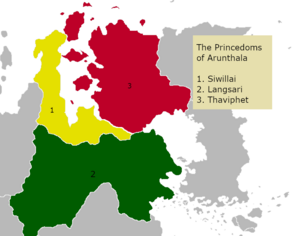
After the death of Janiputra, the realm was divided into three. Siwillai was left to Jirayuwat, the eldest. Janiputra anticipated Jirayuwat to lead his brothers and help maintain stability in the realm after he passed. Kittiphop was left with Langsari, due to his tendency for anger he was left the land that had the least amount of potential for militarization. Songkiat was left with Thaviphet, which originally did not include all of the Ther islands, but due to Rattanakosin being too young to govern, Songkiat maintained rule over them in Rattanakosin's stead.
Almost immediately after inheriting rule over the land that was inherited to him, Jirayuwat mobilized the army for a second invasion into the steppes. He did not trust his brother to govern Lingsara and also sought out the lucrative trade from the region so that he could continue to develop cities in Siwillai. Jirayuwat started the invasion of Langsari in 215 BC and was met with hard resistance in the steppes.
Kittiphop, as it turns out, had grown to be a wise and fair king of Langsari. Although his anger never fully went away, he had learned to cope with it through meditation. Foreseeing potential action against him from either one or both of his brothers, Kittiphop spent a considerable amount of his trade income on the building of fortifications all over the steppes. These include a vast number of fortresses and a networl of tunnels.
When Jirayuwat's armies came into the steppes, they had an incredibly hard time making any territorial gains whatsoever. The war that Jirayuwat had declared on his brother had become a financial quagmire for the kingdom in as little as a few months into the campaign. Kittiphop sent a messenger to their brother, Songkiat, requesting help defending against Jirayuwat's invasion. In response, Songkiat set up a naval blockade along the coasts of Siwilai.
Vassalization under the Myanga Ayil Khanate
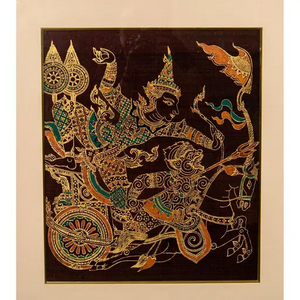
In return for not being conquered, the Great Khan demanded a large contribution of Ther manpower to swell the ranks of his armies. Most scholars tend to agree that Ther military culture was born out of Thervala's vassaliazation under the Khanate. Historical accounts describe divisions of Ther soldiers as incredibly well disciplined and fierce in battle. Ther were typically used as shock troops who specialized in skirmishing and harassment of the opposing army's backline.
One boon of having Thervala as a vassal was Thervala's large population of elephants. Archaeological evidence of Ther Elephants have been found all over Audonia, far outside of their regular habitats and in much greater quantity than trade would permit. There are also written records corroborating the introduction of elephants into the Myanga Ayil Khanate's armed forces as shock cavalry. Some records also report Ther Elephants being used as work and pack animals, due to their capacity to carry large amounts of resources.
The Ther people of the time were largely supportive of the Khanate, due to the reorganization and training of the army in a more modern and standardized capacity. The Khanate was also relatively lenient on taxation and intervention within internal Ther politics. This, however, was not long to last, due to the sheer amount of manpower demanded from the Ther people. Some scholars estimate that the male population of the country shrunk to as little as 35% during the kingdom's time as a Vassal.
Burgoignac Protectorate
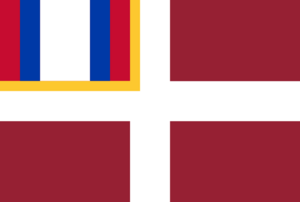
After the defeat of the Myanga Ayil Khanate, The Kingdom of Thervala upheld a treaty signed with the Duchy of Martilles and the Martillien North Levantine Trading Company wherein the Duchy had exclusive rights to trade with and extract resources from the Kingdom of Thervala. In return, Thervala would be Occidentalized, receiving a complete overhaul of the armed forces as well as access to Occidental works pertaining to science, religion, history, and art.
Many of Thervala's largest port cities were founded during this time, including Wat Khram. Wat Khram was founded in a joint venture between the Royal family of Khrima and the Duchy of Martillies to ensure that diplomatic ventures between the two entities wouldn't require long treks through Thervala's jungle. Preexisting cities in the inland areas of the nation were redeveloped to better accommodate intercity commerce, and to ensure that large amounts of goods could be brought towards the port cities for exportation in a much more efficient manner. Before this, they would have had to rely on small caravans traversing Thervala's difficult terrain.
Due to Ther cuisine's abundance of peppers and spices, the kingdom entered into a lucrative trade agreement with the MNLC. Upon Occidentalization, Ther nobility were able to establish large spice plantations which were able to produce peppers and spices en masse. The MNLC also procured land to create spice plantations which were notoriously brutal in their operations. MNLC employees were known to beat, whip, and potentially maim underperforming laborers and their families. Although, some researchers claim that these actions were a reality on Ther owned farms as well.
Military Dictatorship
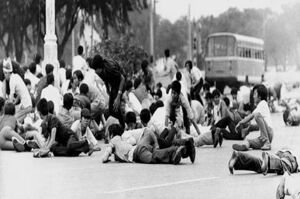
After the coronation of King Ananda Varma I, there was a widespread sentiment for Democratic Socialism in Thervala. Post modernists of the time believed that the monarchy was an outdated institution and that a laity government should be installed. These thoughts were largely influenced by Communist and Socialist thought that had been permeating throughout Audonia at the time. In response to the growing civil unrest and student lead Communist agitation, a state of martial law was declared. An assortment of officers lead by General Prasatthong Kittisak then declared an emergency seizure of power from the king in order to protect him.

After the Kingdom entered a state of emergency, widespread arrests of democratic, communist, and socialist leaders were made. This culminated in a massive riot in Wat Khram. During the riot, small arms fire broke out between the protestors and the Wat Khram Police Department (later reinforced by the Royal Ther Military). This subsequently lead to the 1960 Wat Khram Massacre, where the RTM opened fire on the protestors with military grade weaponry.
This massacre lead to outrage across Audonia, and is considered to be one of the leading causes for the Communist lead conflicts that erupted all over the continent. Domestically, it lead to a coalition between the Democratic, Socialist, and Communist movements in Thervala which was known as the Ther Democratic-Socialist Alliance (TDSA). The TDSA would later radicalize and fully embrace Communist thought, developing into the Ther Freedom Party.
The government's response to the Wat Khram Massacre was to formally outlaw Communist and Socialist organizations within the country as well as severely restrict free speech associated with democracy. The TFP was labeled as a terrorist organization, and its leaders became the most wanted people in Thervala overnight. Most of them fled the country to neutral Metzetta and flew from there to Geisenroda, where they were able to seek political asylum. The TFP in Thervala was then quick to recruit peasantry en masse in the rural provinces of Thervala and form the Red Army of Thervala.
The Red Army of Thervala proceeded to launch a campaign of bombings and skirmishes against the military junta. This lead to a long-term Communist insurgency in the country and acted as a flashpoint between the RTM and the TFP. A conflict which would later bleed into Operation Kipling and inspire Thervala's extensive involvement in it. Burgundie was quick to side with Thervala and offer military and financial aid to the country, even going so far as to recognize the legitimacy of the military junta.
Throughout Operation Kipling, Thervala delegated a majority of its armed forces towards supporting the Liberty Coalition. While the Ther Army provided a lot of manpower towards offensive counter-insurgency efforts in Kandara and Umardwal, a majority of TRA resources were allocated towards occupying and administrating areas afflicted with AudCom-backed paramilitaries. A majority of Ther counter-insurgency operations were performed by Royal Ther Marines. Actions performed by the Ther Military at the time were under reported on, especially in Thervala. Some atrocities committed by Royal Ther Marines would not be acknowledged by the monarchy or Ther government until the mid 2010's.
Thervala's involvement in Operation Kipling and role as a springboard for troop movement into eastern Audonia lead to great economic stimulation in the country. Contemporary fascist thinkers in Thervala attribute the modern Ther economy to the mobilized wartime economy and increased levels of commerce that came with it. Despite his death in the 1980 Ther democratic coup and ruthless persecution of liberal thinkers, many Ther people see Marshall Kittisak as a national hero.
Post Kipling
The Bubble Economy
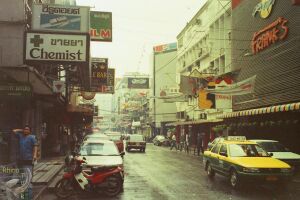
After the establishment of a democratic government and the restoration of the monarchy as the supreme administrative authority in the Kingdom of Thervala, the nation entered a long period of stability and relative calm. This era was marked by significant economic changes driven by various policy reforms aimed at encouraging growth and attracting investment.
The democratic government introduced several measures to stimulate the economy, including easing access to credit, which allowed both individuals and businesses to obtain funding more easily. They also implemented substantial tax cuts, increasing disposable income for citizens and encouraging corporate investment. Additionally, the deregulation of various sectors created an environment that supported entrepreneurial activities and innovation.
As a result, Wat Khram became a financial hotspot in Northern Audonia. The Kingdom's lax economic policies and identifiable tax loopholes attracted a wide range of domestic and international investors. This influx of capital led to a sharp rise in stock prices, reflecting increased market confidence and corporate expansion. Consequently, Thervala experienced an economic boom, with significant growth in sectors such as finance, real estate, and technology.
International and domestic invesetors flooded the Ther stock market, with stocks from Ther companies reaching unprecedented highs. Thervala's stock market was no longer measured by the success of its companies, but from speculation and confidence. Property values in Wat Khram, Wat Vishram, and Sattabhaya skyrocketed, leading to entire neighborhoods being razed and rebuilt to cash in on the burgeoning success in the economy.
Thervala adopted a heavy consumer culture throughout the 1980s. Many Ther companies benefited greatly from the economic climate of the times, and many of Thervala's most beloved entertainment industries were born. Most notably, Surasan released the Chaocon. It was one of the first ever home computers exclusively meant for running video games. Voralex would also spring onto the scene with its Nexar, a direct competitor to Surasan.
Ther economic prosperity only lasted through the decade, the 1991 North Audonian Financial Crisis to rapid deflation of the economy in the 1990s. This was due to a lack of foreign currency entering the country, leading to the government not being able to support it's currency peg to the Taler. The country's economy spiraled overnight due to investers pulling out of the country in droves, causing one of the largest instances of capital flight in history. The kingdom had to take on a massive amount of foreign debt to stabilize the country and bail out domestic banks at the cost of Stipends for Kipling veterans and pensioners.
The Bubble Pop
Throughout the 1990s crime skyrocketed in Thervala. The monarchy enacted the State Police Act of 1992 to combat this, which replaced local and municipal police forces with Royal Ther soldiers. While this action did bring relative stability to Thervala as well as help to decrease the crimerate, the Royal Ther Army Police became infamous for extorting provincial towns for large sums of money. Thervala oversaw the end of the 99 year Burgo-Ther military lease in the winter of 1992, many Ther people saw the departure of Burgoignac Security Forces as the end of an Era for Thervala.
In 1995 the Ther government enacted the Royal Ther Inernational Diplomatic initiative. Seeking to revitalize Thervala's economy through means of tourism, Ananda Varma I created a million Taler fund for Ther cooks and restaurantiers to go abroad and open up authentic Ther cuisine. The government hypothesized that this would spark interest in Thervala in the far reaches of the globe where it might be unheard of. By and large, this is now considered to be a great success as Ther cuisine is household knowledge worldwide. At the time, however, it was seen as a very strange decision.
One of the more infamous results of the Ther economic bubble popping is the widespread prostitution that occured directly thereafter. Prostitution was formerly competely outlawed in Thervala, due to the highly religious nature of the country. Many foreign investors and businessmen had been sentenced to long tenures in prison due to the solicitation of prostitutes during the bubble economy. This became a much bigger problem when the economy crashed and was exacerbated due to the RTAP's corruption. As much as 60% of the RTAP in Wat Khram frequented Brothels or Street girls during their time as the acting police force. To combat this and potentially help the economy, the government decided to fully legalize prostitution. This helped to protect the rights and safety of working women as well as their ability to set their prices.
The Ther Migrant Crisis
After the near collapse of the Ther economy and the dramatic increase of crime within the country, thousands of Thers decided to leave the country for a more stable one. Years of conflicts within the government and supporting Burgoignac wars had left many Ther people feeling jaded towards their nation and government. A mass exodus of an estimated 150,000 Thers left the country for Ogonkai between 1992 and 1994. Meetings between King Ananda Varma I and the government of Ogonkai took place sometime between spring of 1992 and fall of 1993. During this time, the two parties met and talked about what is to be done with the border crisis. The two parties agreed that if the migrant crisis was to be stopped in any long term and meaningful way it would be through using the military.
Shortly after these meetings the King met with the head of the RTAP as well as the director for the RTA Counter Terrorist division to plan out a long term policing solution for major urban centers in Thervala. While these meetings remained secret for decades, evidence of their existence came forth when a Palace staffer leaked sensitive documents onto X in 2026. This lead to a great public outrage against the monarchy, largely against King Ananda Varma II. It has also put a stain on the legacy of Thervala's most beloved monarch, his father, Ananda Varma I.
The Kipling Riots

In may of 1995 the RTMVA (Royal Ther Military Veterans Association) organized a protest outside of the Royal Assembly house in Wat Khram. Veterans from operation kipling had had their pension cut entirely after the economic fallout of the bubble popping. Police descended upon the protest en masse but were soon outnumbered as civilians joined in with the protestors. The protest then swelled into an all out riot with small arms fire being exchanged between rioters and the police. A blockade was created around the Royal Assembly house from cars and debris, effectively trapping staffers and govenrment officials in the building.
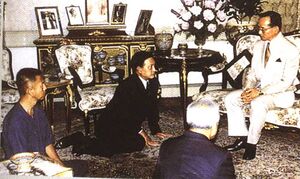
The RTMVA and the rioters had assumed that another coup was bound to take place. They believed that the RTA and RTMC would side with the plight of the kipling veterans. Instead, the RTA counter terrorist division was deployed to the riots in Wat Khram, resulting in an intense firefight with the rioters. Due to there being many officers among the veterans in the RTMVA, the rioters organized well and were able to repel multiple attacks from the RTA. The culmination of the riots came after the third repelled attack resulted in the RTA deciding to use lethal force to disband the protest.
The resulting massacre was second only to the 1960 Student lead protests. The RTA stormed the rioters with shotguns and teargas, resulting in a mass route as well as the deaths of 120 civilians and veterans of Operation Kipling. Consequently, the head of the RTMVA and the acting director of the RTA's counter terrorist division were brought before the king. The both of them were brought to postulate on the ground before the king and apologize for both of their behaviour on live television. King Ananda Varma I personally oversaw the creation of a fund for the families of the effected survivors as well as a fund for military pensioners so that a riot of this nature would never happen again.
Economic stability
The political fallout from the riots and subsequent massacre resulted in a lack of trust in both the monarchy and the government. It is considered to be the definitive end of what many in Thervala refer to "The Hellish decade". Soon after the Kipling riots, the Royal Ministry for Treasure was able to convince the government to cut military spending by 15%. The resulting surplsus of funds allowed the government to operate with lower tax rates, lower interest rates on loans, and lowered defecit spending rates. Burgundie and Oyashima were crucial during this time as the kingdom took low interest rate loans from both nations to mitigate the fiscal impact from lowering taxes.
Investors slowly returned to Thervala, but never again at the rates seen in the frenzied manner of the 1980s. The late 1990s and early 2000s saw the Kingdom's economy shift its importance towards its tourist industry. Virtually all franchises in Thervala operate under the Thervala Tax Free Act. This enables tourists to shop at any Ther franchise in the country with no sales tax for purchases over 5000 Rathan. The kingdom also introduced a litany of new visas for foreign skilled laborers and researchers to enter the country with a government dispensation to contribute to the development of Ther interests domestically.
Geography
-
Wat Khram at sunset
-
Phin Krat, a popular tourist destination - the largest island in the inner Ther peninsula
-
The National Buddha of Thervala, located on the outskirts of Wat Khram
-
The Imperial Palace of the Khram Dynasty
-
Wat Vishran, the ancient capital of the Vishran Kingdom
Climate and environment
Thervala is a subtropical nation with a large amount of marshland on its mainland Audonian territory. A mountain range to its south makes up a natural border between The Kingdom of Thervala and its bordering nations. The central part of the nation is largely tropical and is comprised of the main Peninsula of Thervala which has over a thousand islands. In the southwest of the country is the Thrak'Tee river. The Thrak'Tee river flows from central Audonia all the way to Wat Khram.
Government and Politics
The Kingdom of Thervala is governed by a de facto democratically elected civilian government but a de jure military government via majority seats in government.
Executive
The King of Thervala is largely a figurehead, but still retains a handful of executive functions and remains influential over the legislature. The main wielder of executive power in the country is the prime minister, who is an elected representative from the legislature. A majority of legislation drafted and passed by the legislature is written "in the interest" of the king.
Legislative
The legislative branch of the country is made up of an upper and lower house, which are comprised of elected officials from the various political parties of the country. Each political party elects a representative who will then run for the position of prime minister.
Changwats

The Kingdom of Thervala is comprised of six Changwats and one "Special Archipelagic Administrative Region". Thervala's administrative borders were first drawn by the Arunid-Ther king Janiputra. Thervala has mainly retained these original borders with slight changes. Those being the designation of Thervala's Audonian islands as a Special Administrative region and the addition of Wat Khram given a Changwat of its own. Most Ther provinces are fairly autonomous in administration and legislation, though there are laws that are enforced on a federal level. The Special Archipelagic Administrative Region and Wat Khram are both governed completely on the federal level. The SAAR operates under de facto autonomy and is primarily a region dedicated to economic growth and development. It has some of the most lax tax laws in the country, so many businesses are headquartered there. This region has always been economically prosperous, due to the heavy development done to make ports here by Burgundie to better facilitate trade.
The Wat Khram Changwat is dedicated to the administrative area of Wat Khram and surrounding cities. This is where the capital of the country is located and receives the highest amount of tourists of any other province.
Politics
Thervala has a handful of major political parties that ebb and flow in power. However, since the 1980 democratic coup, the ruling party has been the Royal party. The other major parties that have consistently held seats in the Ther parliament are the Fascist Party of Thervala (FPT), Thervala Social Democrat Party (TSDP), and the Green Party.
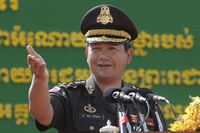
Communism and Socialism are completely outlawed in the Kingdom of Thervala. There was a large scale communist insurgency in Thervala during Operation Kipling that resulted in a handful of terror attacks, widespread skirmishes in the Ther jungle, and the banning of the political party in Thervala. Thervala does have an unofficial communist government in exile, the Ther Freedom Party (TFP). This party was founded alongside members of the Ther communist paramilitary and domestic terrorist organization, the Red Army of Thervala (RAT).
Law
Thervala is infamous the world over for its extremely harsh legal system. It employs torture of all kinds and has a sentencing rate of 97.5%. Prisons in the Kingdom of Thervala are also incredibly strict, regimented, and allegedly rife with human rights abuses. In Thervala, there is no separation between the military and law enforcement, they are one in the same. Thervala has an incredibly low crime rate due to its incredibly strict punitive measures.
Demographics
Ethnicity
Self-reported ethnic origin in the Kingdom of Thervala (2030)
The majority ethnic group in Thervala is the Ther people, followed by Daxian Ther (Daxian merchants that historically settled in Thervala during its time as a Burgoigniac Protectorate. As such, there is also a growing population of Bergendii people in Thervala, due to the historically close ties the two nations have. A good amount of foreign skilled labor comes either from Burgundy or Thervala's fellow Burgoigniac Protectorate and neighbor, Oyashima.
There is also a small community of Peshabi people in Thervala that are descended from the original Vishrani settlers of the region. They face social ostracism and are treated as second class citizens to this day. Such treatment is the root of some concerns had by the League of Nations and human rights organizations.
The rest of Thervala's population consists of immigrants from neighboring Audonian nations such as Metzetta and skilled labor from nations in Levantia.
Language
Ther is the predominately spoken language in Thervala. Due to the kingdom's historic ties with Burgundie, Burgoignesc is a common second language as it is required by law to be taught in school. Oyash and Daxian are also spoken in Thervala, usually within immigrant communities.
Religion
The majority religion in Thervala is Vattaya Buddhism. It is also the state religion. There is also, however, a very large Christian minority in the nation. Christians make up a quarter of the population of Thervala, with a roughly even split between Catholics and Protestants.
Culture and Society
Education
The Kingdom of Thervala has compulsory school attendance. The government pays for both primary schooling and higher education. This process is based solely on merit, so higher education is incredibly competitive. Royal military personnel are virtually guaranteed a position within a Ther university post service.
Attitudes and worldview
The Kingdom of Thervala has a longstanding religious tradition and Theravada Buddhism is integral to Ther culture and society.. Due to Thervala's intense adherence to religion and stratified, monarchical society, it is known for being one of the most collective countries in the world. Each and every Ther citizen views themselves as having a role in society and they must perform their role to the best of their abilities. Because of this, military service is an incredibly esteemed profession and the Royal Military is never in short supply of new recruits.
It is not uncommon in Thervala to see the old and infirm working menial jobs on the street. Work and responsibility to one's family is paramount to the Ther, even during sickness and old age. Such responsibilities can only be abandoned in the gravest of circumstances, such as intense or terminal illness.
Kinship and family
For the common person family is very important, a majority of people live in multi-generational households and even maintain close relations to distant family. For the upper class, there is a quasi-cast of nobility that has survived since the original Khram dynasty. There are many noble families that maintain high ranking positions within Ther society. There are even some Peshabi people alive today who can trace their ancestry back to the court of the Vishran Dynasty.
Cuisine
Ther cuisine is very diverse in terms of cooking style and ingredients. Ther dishes tend to consist of hot peppers, vegetables, rice or noodles, and a meat of some kind. Ther cuisine is, however, incredibly diverse due to influence from Arunid, Central Audonian, and Burgoignac cuisines. It is considered to be one of the most delicious and flavorful cuisines in the world. Ther restaurants are beloved and renowned worldwide thanks to the Government's movement in the early 2010's to train and subsidize up-and-coming entrepreneurs so they could open up Ther restaurants around the world. The Ther government refers to this practice as 'Gastrodiplomacy', and it is now considered to be a wildly successful strategy. Some notable examples of Ther dishes are as follows: Ther Curry, Pad Ther, Krat Wi Dap, and Bahn Mip.
Religion
Vattayan Buddhism
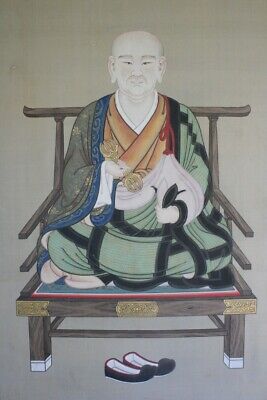
Buddhism was brought to Thervala around 300 BCE when Arunid princes introduced it to the indigenous Ther people. As such, Buddhism is vital to Ther culture and identity, every Ther monarch since the establishment of the Kingdom has been a Buddhist. The Buddhism practiced in Thervala is known as Vattanaya Buddhism. It is unique in that it encourages just killing (such as killing in self defense, in war, and as a method of execution) to accelerate the cycle of death and rebirth so that more people can achieve Nirvana faster. Suicide, however, is considered to be the penultimate form of sacrilege. It is suggesting that one has decided that they have learned and experienced enough in their own life and are ready to move on to the next.
In Thervala euthanasia, capital punishment, and sometimes abortions are all overseen by Vattayan monks. In instances of capital punishment and euthanasia, the monk will personally kill the recipient whilst uttering blessings upon them. To Vattayans, it is considered a great honor to receive the death penalty or to be euthanized, as one will then re enter the cycle of death and rebirth so one may once more have a chance at attaining enlightenment.
Due to the nature of Vattayan Buddhism, the Ther Military is a venerated institution within the religion. Many Vattayan monks in training go through a phase where they are temporarily laification so that they have an oppurtunity to spend time within the Royal Ther Military. Such a tenure is required to become a full fledged Monk. During Operation Kipling, many saints and martyrs were proclaimed due to the actions of Vattayan soldiers and marines serving within the Ther military. There have even been instances of career officers retiring from their positions later in life to become monastics in their final years. The Vattayan schools celebration of historic Ther war crimes have been a source of diplomatic tension between Thervala and other countries.
The Vattayan school of Buddhism was founded by a Ther monk known as Lai Kin Kut. Not much of Lai Kin Kut's early life or his acts have been recorded. It is known that around the middle of his life he was brought to the court of King Chatkra Krahm I. Lat Kin Kut had developed a celebrity status amongst Buddhist scholars and laity alike due to his alleged performance of miracles as well as his profound wisdom. Lat Kin Kut acted as a political and spiritual advisor for the king. His actions in the court garnered him a following of pupils that wanted to learn from his wisdom.
With permission from King Chatkra Krahm I, Lat Kin Kut alongside ten of his most trusted disciples departed the royal court. Lat Kin Kut was given a parting gift from the king, an endowment to build a monastery on the outskirts of Wat Vishran. For the rest of his life, Lai Kin Kut presided over the monastery and produced many monks. Near the later end of his life, a small council of elders was formed to discuss the dogma of the school as well as what is to be done after Lai Kin Kut passed away. The council of elders decided that Lat Kin Kut's quality of life was rapidly starting to decline due to his age, so they agreed to administer the sacrament of release to him. They brewed Lai Kin Kut poisonous tea.
"The sacrament was administered. The master's favorite Daxian Black Tea was mixed with the deadly Kingly Dragon's Venom. After our meeting over evening tea, the master retired to his dwelling and fell to sleep. After an hour, Kitt Tran entered to check on the master, who reported that he had passed in a 'Divine manner'. The master had a holy glow about him and died whilst he reclined, much like Phrah Pooth Thah. Truly, he was a Bodhisattva. None of us were willing to remove him from his dwellings, as we were not holy enough. We left him there for eight days and eight nights before we removed him. Where we buried him, a great tree has sprouted. In death, he achieved Nirvana."
Christianity

While a majority of Ther were apathetic towards evangelical attempts by missionaries from Levantia, the lower castes of Ther society took a great interest in Christianity. Christian teachings broke Ther social norms in a way that allowed the ostracized members of Ther society to have an accepting community. Many Ther people traveled to Levantia to study Theology during the period of Occidentalization. Most Ther scientists and scholars at the time were formally educated by Christian institutions in Levantia. Upon returning back to Thervala, many of these converts helped to establish parishes and Christian monasteries in Thervala. These early Christian-Ther institutions helped to lay the foundation for Thervala to become more Occidental in nature.
Ther Catholics are reknown for going above and beyond in their veneration of the sacred mother. During the Feast of the Assumption, it is parishes from all over an Archdiocese will congregate at the Cathedral with statues of the blessed mother made by the members of each parish respectively. Contemporary Occidental Christians sometimes view Ther Catholic practices to be on the more extreme side in terms of venerating saints or the Virgin Mary. Another more extreme part of the Ther Catholic tradition are the reenactments done by volunteers during Easter. While most Catholics around the world celebrate Easter through mass and feasting, the more devout Ther Catholics will volunteer themselves to be tortured and crucified on Good Friday. This practice is mainly for the remembrance of the suffering of Jesus Christ. The Papal State and the Catholic Church of Thervala both condemn the practice.
Habass Veneration
Ther-Catholics view Habass as an early Christian saint who Jesus freed during the Harrowing of Hell.
Arts and Literature
The Ther people have had a rich tradition of storytelling dating back to before the arrival of the Vishrani princes. Most of these stories and traditions were transcribed in ancient Arunid and eventually into written Ther. The central Ther cultural canon is known as 'The 32 Divine Vedas'. While this does not comprise the entirety of ancient Ther folklore, it is considered to be the most culturally salient. A majority of what is known of early Ther religion comes from these texts and ancient Ther deities and myths are talked about at length.
Vishrani-Ther literature primarily consists of works commissioned by Vishrani nobility. While most were lost to time when the Vishrani were ousted, a handful of manuscripts were preserved. Either due to their authors holding onto them or culturally sensitive Thers that saw the significance of the works. The most famous of these works is known as Seven Heavens, Seven Hells. It was an epic, allegedly commissioned by King Surya Vishrani that told the tale of a Ther warrior named Surasaktra. Surasaktra was tasked by his king to save the king's princess, who was so beautiful that the great god Vithranaya kidnapped her. Vithranaya makes a deal with the king - that if he could find a subject willing to travel through all of the realms and complete an increasingly difficult amount of tasks he would have his daughter released to him. Other notable works from this era of Ther literature include Letters to the Great Dragon and The Pilgrimage of 99 Heavenly Temples.
During the period of vassalization, there was a noticeable lull in the creation of great works of art in Thervala. The Khanate had no use for Ther culture and the production of such art was considered to be feminine.
Economy and Infrastructure
Industries and Sectors
Thervala has a mixed-market economy. The country's economy is primarily driven by international tourism, the defense industry, and agriculture. Thervala's red light districts are estimated to produce anywhere between 12% - 18% of the country's GDP, conservative estimates place this at 4.1 Million USD. Thervala's armed forces also contribute greatly to the country's economy, producing both skilled and non skilled laborers that are ready to enter the workforce post service.
Thervala's primary export is machinery. Thervala produces a large amount of automobiles, construction machinery, and parts for both. Thervala's second largest export are Electronics such as integrated circuits and semi conductors.
Thervala also has an incredibly diverse domestic market and chooses not to import brands from a majority of countries, with the exception of Burgundie. Chantara Beverages, as an example, is Thervala's leading soft drink and alcohol manufacturing company. They produce Thervala's primary beer, Chang, as well as a variety of yogurt and fruit based drinks.
Currency
The Ther currency is known as the Rathan. Bank notes are distributed in the 1,000, 1,500, 3000, 5000, and 10,000 denominations. As for coinage, there are 5, 10, 50, 100, 250, and 500 denominations. Bills are stylized with Ther kings on the face half and natural landmarks on the back half. Coins have the number on the face half and Buddhist monks or imagery on the tails half.
Healthcare
Healthcare is completely paid for by the King in Thervala as it is his religious duty to do so. This is only a domestic policy, though, and more advanced medical issues that are treated outside of the country must be paid for out of pocket. Such cases are usually treated in Oyashima.
Labor

Labor unions are highly illegal in Thervala due to their association with socialist and communist movements. There are, however, very strict labor and safety laws that are enforced as much as possible. These are more prevalent in more urban areas, as rural areas do not have the administrative presence for such things to be enforced.
Transportation
The Kingdom of Thervala has a very comprehensive rail network, with access to each major city within the 10 provinces of the country. Within each city major city there are also large, extended urban metro lines. Designers and engineers were hired from Oyashima to help design these networks. Within the inner Ther peninsula, there is also a network of ferries dedicated to taking people between islands as well as to and from the mainland.
Technology
Thervala has historically had to rely on more advanced, foreign powers for its technological advancements. It is able to currently maintain a modern level of technology due to its proximity to Oyashima and close ties with Burgundie. Rural Thervala is incredibly technologically stagnant, though, and does not enjoy many of the luxuries of the Ther urban centers.
Military

The Kingdom of Thervala's military is a large and elite force. It has served alongside the Burgoignac military in every major armed conflict since the 1500's and has thus maintained a very experienced body of troops. It is the military's responsibility to act as law enforcement within the civilian sector as well as to protect the monarchy. The King and relatives of the king also precede over their own regiments within the military. Membership in such regiments is considered to be a highly esteemed honor.
Membership within the Ther military is highly sought after, due to its boons in regards to social mobility and education. Recruits are typically picked from high schools around the nation, and recruitment officers tend to make their decisions based off of academic merit as well as physical prowess. As such, high school sports teams tend to yield the highest amount of recruits into the military.
Officers within the Ther military are virtually all enlisted men that have served long enough to have enough experience for the role. There do exists programs within Ther universities for Officers to be recruited from student bodies. These officers, however, are few and far between.

